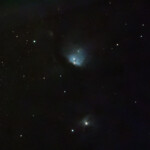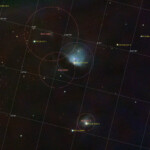M78 is the brightest diffuse reflection nebula of a group of nebulae that includes NGC 2064, NGC 2067 and NGC 2071. This group belongs to the Orion B molecular cloud complex and is about 1,350 light-years distant from Earth. M78 is easily found in small telescopes as a hazy patch and involves two stars of 10th and 11th magnitude. These two B-type stars, HD 38563 A and HD 38563 B, are responsible for making the cloud of dust in M78 visible by reflecting their light.

M78
Messier 78 also known as NGC 2068, is a reflection nebula in the constellation Orion.
M78 is the brightest diffuse reflection nebula of a group of nebulae that includes NGC 2064, NGC 2067 and NGC 2071. This group belongs to the Orion B molecular cloud complex and is about 1,350 light-years distant from Earth. M78 is easily found in small telescopes as a hazy patch and involves two stars of 10th and 11th magnitude. These two B-type stars, HD 38563 A and HD 38563 B, are responsible for making the cloud of dust in M78 visible by reflecting their light.
The M78 cloud contains a cluster of stars that is visible in the infrared. Due to gravity, the molecular gas in the nebula has fragmented into a hierarchy of clumps,whose cores have masses ranging from 0.3 M☉ to 5 M☉.About 45 variable stars of the T Tauri type, young stars still in the process of formation, are members as well. Similarly, 17 Herbig–Haro objects are known in M78.
Photographed with RC8 reflector telescope and ASI 2600MC color camera in Stuvsta, March 2023. Exposure was 29*1 min ans IDAS HEUIB filter.

M78
Messier 78 also known as NGC 2068, is a reflection nebula in the constellation Orion.
M78 is the brightest diffuse reflection nebula of a group of nebulae that includes NGC 2064, NGC 2067 and NGC 2071. This group belongs to the Orion B molecular cloud complex and is about 1,350 light-years distant from Earth. M78 is easily found in small telescopes as a hazy patch and involves two stars of 10th and 11th magnitude. These two B-type stars, HD 38563 A and HD 38563 B, are responsible for making the cloud of dust in M78 visible by reflecting their light.
The M78 cloud contains a cluster of stars that is visible in the infrared. Due to gravity, the molecular gas in the nebula has fragmented into a hierarchy of clumps,whose cores have masses ranging from 0.3 M☉ to 5 M☉.About 45 variable stars of the T Tauri type, young stars still in the process of formation, are members as well. Similarly, 17 Herbig–Haro objects are known in M78.
Photographed with RC8 reflector telescope and ASI 2600MC color camera in Stuvsta, March 2023. Exposure was 29*1 min ans IDAS HEUIB filter.